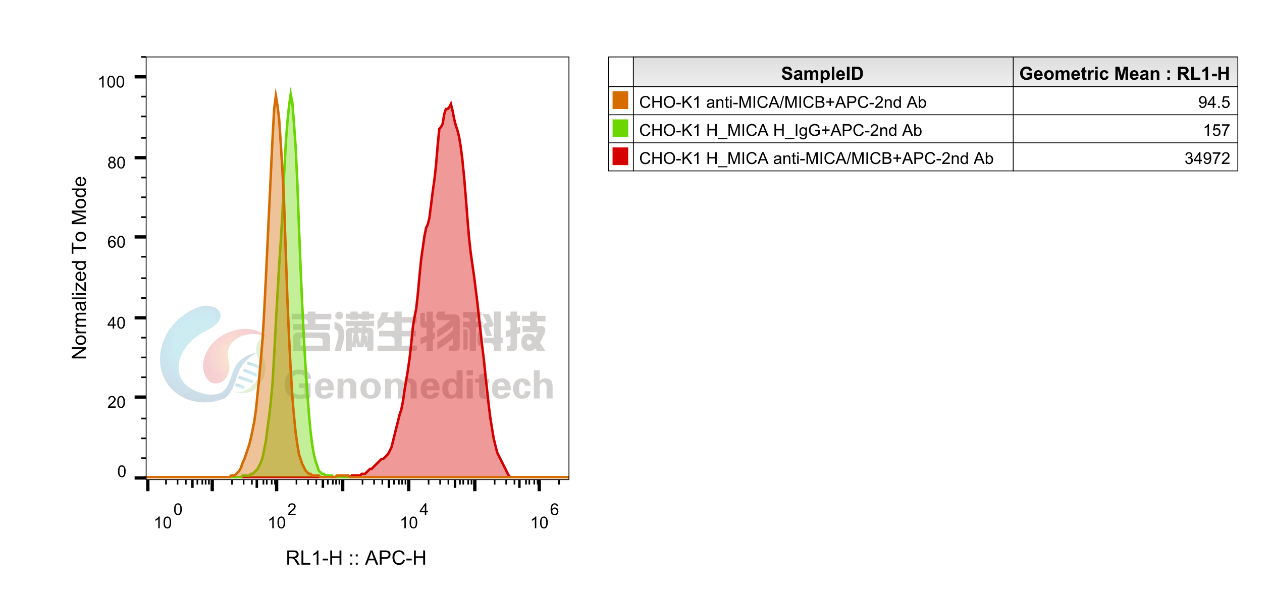Cat.No:GM-48843AB
Product:Anti-MICA/MICB hIgG1 Antibody(36 NF G236A)
Cat.No:GM-48843AB
Product:Anti-MICA/MICB hIgG1 Antibody(36 NF G236A)
GM-48843AB-10 10 μg
GM-48843AB-100 100 μg
GM-48843AB-1000 1 mg
Species Reactivity | Human |
Clone | 36 NF G236A |
Source/Isotype | Monoclonal Human IgG1 /κ |
Application | Flow Cytometry |
Specificity | Detects MICA and MICB. |
Gene | MICA and MICB |
Other Names | MIC-A,PERB11.1; |
PERB11.2 | |
Gene ID | MICA: 100507436(human) |
MICB: 4277(human) | |
Background | MHC class I polypeptide–related sequence A (MICA) is a highly polymorphic cell surface glycoprotein encoded by the MICA gene located within MHC locus. MICA is related to MHC class I and it has similar domain structure; however, it is not associated with β2-microglobulin nor binds peptides as conventional MHC class I molecules do MICA rather functions as a stress-induced ligand (as a danger signal) for integral membrane protein receptor NKG2D ("natural-killer group 2, member D"). MHC class I polypeptide-related sequence B (MICB) is a protein that is encoded by the MICB gene located within MHC locus. MICB is related to MHC class I and has similar domain structure, which is made up of external α1α2α3 domain, transmembrane segment and C-terminal cytoplasmic tail. MICB is a stress-induced ligand for NKG2D receptor. The heat shock stress pathway is involved in the regulation of MICB expression as transcription of MICB is regulated by promoter heat shock element |
Storage | Store at 2-8℃ short term (1-2 weeks).Store at ≤ -20℃ long term.Avoid repeated freeze-thaw. |
Formulation | Phosphate-buffered solution, pH 7.2. |
Endotoxin | < 1 EU/mg, determined by LAL gel clotting assay |



Cat.No:GM-48843AB
Product:Anti-MICA/MICB hIgG1 Antibody(36 NF G236A)
GM-48843AB-10 10 μg
GM-48843AB-100 100 μg
GM-48843AB-1000 1 mg
Species Reactivity | Human |
Clone | 36 NF G236A |
Source/Isotype | Monoclonal Human IgG1 /κ |
Application | Flow Cytometry |
Specificity | Detects MICA and MICB. |
Gene | MICA and MICB |
Other Names | MIC-A,PERB11.1; |
PERB11.2 | |
Gene ID | MICA: 100507436(human) |
MICB: 4277(human) | |
Background | MHC class I polypeptide–related sequence A (MICA) is a highly polymorphic cell surface glycoprotein encoded by the MICA gene located within MHC locus. MICA is related to MHC class I and it has similar domain structure; however, it is not associated with β2-microglobulin nor binds peptides as conventional MHC class I molecules do MICA rather functions as a stress-induced ligand (as a danger signal) for integral membrane protein receptor NKG2D ("natural-killer group 2, member D"). MHC class I polypeptide-related sequence B (MICB) is a protein that is encoded by the MICB gene located within MHC locus. MICB is related to MHC class I and has similar domain structure, which is made up of external α1α2α3 domain, transmembrane segment and C-terminal cytoplasmic tail. MICB is a stress-induced ligand for NKG2D receptor. The heat shock stress pathway is involved in the regulation of MICB expression as transcription of MICB is regulated by promoter heat shock element |
Storage | Store at 2-8℃ short term (1-2 weeks).Store at ≤ -20℃ long term.Avoid repeated freeze-thaw. |
Formulation | Phosphate-buffered solution, pH 7.2. |
Endotoxin | < 1 EU/mg, determined by LAL gel clotting assay |


